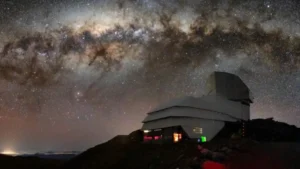A space probe operated by the United Arab Emirates captured groundbreaking high-resolution images of Martian moonlet Deimos earlier this year. These first-of-their-kind observations could help identify the moonlet’s mysterious origins.
Mission science lead Hessa Al-Matroushi shared the Amal — Arabic for Hope — probe data at a geoscience meeting in Vienna this week.
The Hope probe took the photographs on a March 10 flyby. The images are striking for their clarity (they almost look computer generated) and their perspective.

Modern sensors allowed the Hope probe to capture this detailed perspective on Deimos. Photo: United Arab Emirates Space Agency
Like Earth’s moon, any observations taken from Mars’ surface only show the “light” side of Deimos. But the Hope probe has an orbit that allows it to glimpse the side of Deimos we’ve never seen before, and the results are fantastic.
“Mars was in the background — and that was just mind-blowing, honestly,” Al-Matroushi told Nature.
Shedding light on a moonlet’s origins
Using three onboard sensors, scientists gathered readings suggesting that Deimos has a makeup similar to Mars. This supports the theory that the moonlet formed concurrently with Mars and isn’t a captured asteroid.
“How exactly [Phobos and Deimos] came to be in their current orbits is an active area of study, and so any new information we can gain on the two moons, especially the more rarely observed Deimos, has the potential to unlock an understanding of Mars’ satellites,” Al-Matroushi explained to PetaPixel. “Our close observations of Deimos so far point to a planetary origin.

Two shots of Deimos side by side. Photo: United Arab Emirates Space Agency
The Deimos observations are somewhat of a bonus for the Mars mission. The probe launched in July 2020 to study Mars’ seasonal weather patterns. With that mission concluded, the Hope team noticed they had enough propellant left over to launch Hope into an intersectional orbit with Deimos.

A stereoscopic view of Deimos captured by the Hope probe. Photo: United Arab Emirates Space Agency
Mars’ two orbiting bodies, Deimos and Phobos, are named after minor gods in the Greek pantheon. Deimos (god of terror and dread) and Phobos (god of panic and flight) often accompanied their father Ares to battle sites.
But Hope is the antithesis of fear. And the probe’s March 10 flyby is the first of many to come.






